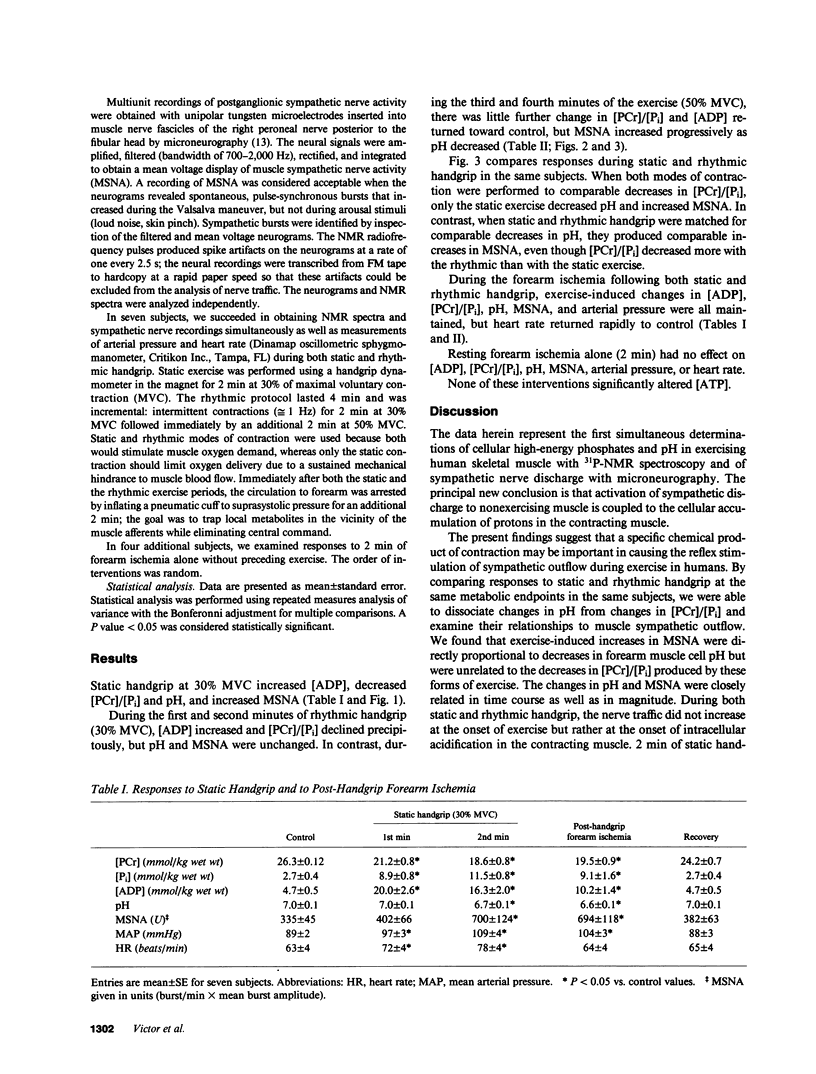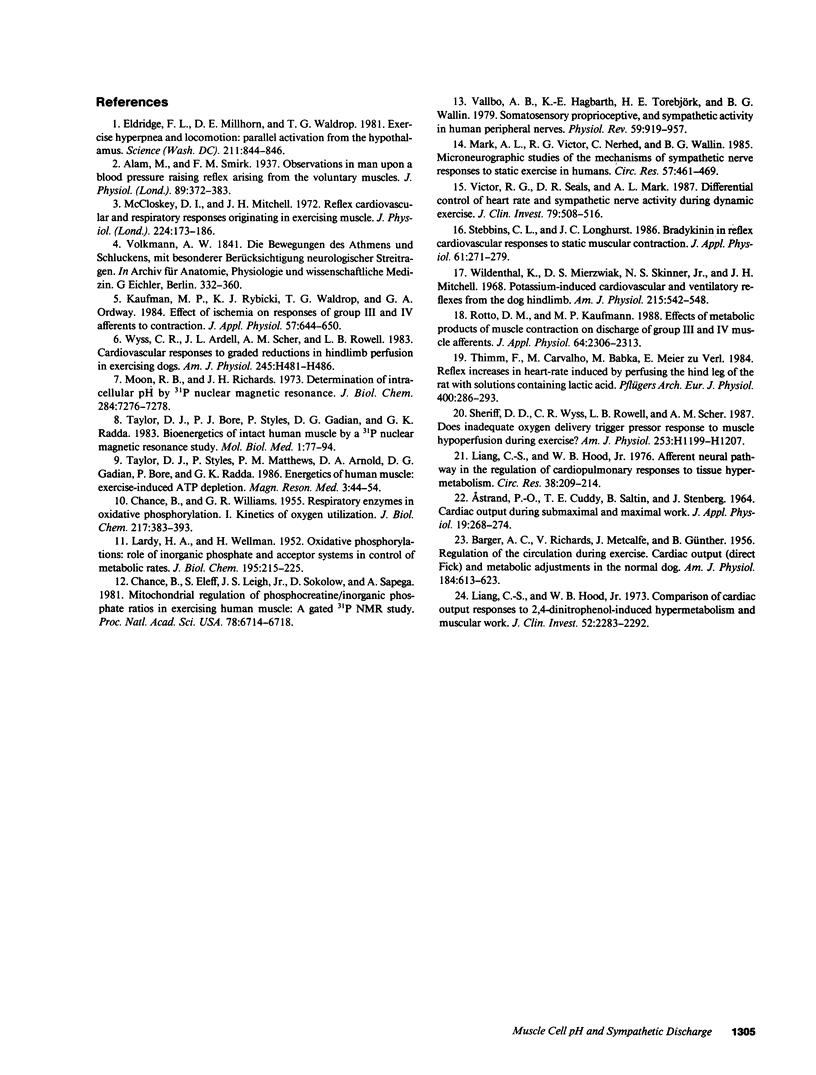Abstract
We used phosphorus nuclear magnetic resonance spectroscopy (31P-NMR) to probe the cellular events in contracting muscle that initiate the reflex stimulation of sympathetic outflow during exercise. In conscious humans, we performed 31P-NMR on exercising forearm muscle and simultaneously recorded muscle sympathetic nerve activity (MSNA) with microelectrodes in the peroneal nerve to determine if the activation of MSNA is coupled to muscle pH, an index of glycolysis, or to the concentrations (II) of inorganic phosphate (Pi) and adenosine diphosphate (ADP) which are modulators of mitochondrial respiration. During both static and rhythmic handgrip, the onset of sympathetic activation in resting muscle coincided with the development of cellular acidification in active muscle. Furthermore, increases in MSNA were correlated closely with decreases in intracellular pH but dissociated from changes in phosphocreatine [( PCr]), [Pi], and [ADP]. The principal new conclusion is that activation of muscle sympathetic outflow during exercise in humans is coupled to the cellular accumulation of protons in contracting muscle.
Full text
PDF




Selected References
These references are in PubMed. This may not be the complete list of references from this article.
- ASTRAND P. O., CUDDY T. E., SALTIN B., STENBERG J. CARDIAC OUTPUT DURING SUBMAXIMAL AND MAXIMAL WORK. J Appl Physiol. 1964 Mar;19:268–274. doi: 10.1152/jappl.1964.19.2.268. [DOI] [PubMed] [Google Scholar]
- Alam M., Smirk F. H. Observations in man upon a blood pressure raising reflex arising from the voluntary muscles. J Physiol. 1937 Jun 3;89(4):372–383. doi: 10.1113/jphysiol.1937.sp003485. [DOI] [PMC free article] [PubMed] [Google Scholar]
- BARGER A. C., RICHARDS V., METCALFE J., GUNTHER B. Regulation of the circulation during exercise; cardiac output (direct Fick) and metabolic adjustments in the normal dog. Am J Physiol. 1956 Mar;184(3):613–623. doi: 10.1152/ajplegacy.1956.184.3.613. [DOI] [PubMed] [Google Scholar]
- CHANCE B., WILLIAMS G. R. Respiratory enzymes in oxidative phosphorylation. I. Kinetics of oxygen utilization. J Biol Chem. 1955 Nov;217(1):383–393. [PubMed] [Google Scholar]
- Chance B., Eleff S., Leigh J. S., Jr, Sokolow D., Sapega A. Mitochondrial regulation of phosphocreatine/inorganic phosphate ratios in exercising human muscle: a gated 31P NMR study. Proc Natl Acad Sci U S A. 1981 Nov;78(11):6714–6718. doi: 10.1073/pnas.78.11.6714. [DOI] [PMC free article] [PubMed] [Google Scholar]
- Eldridge F. L., Millhorn D. E., Waldrop T. G. Exercise hyperpnea and locomotion: parallel activation from the hypothalamus. Science. 1981 Feb 20;211(4484):844–846. doi: 10.1126/science.7466362. [DOI] [PubMed] [Google Scholar]
- Kaufman M. P., Rybicki K. J., Waldrop T. G., Ordway G. A. Effect of ischemia on responses of group III and IV afferents to contraction. J Appl Physiol Respir Environ Exerc Physiol. 1984 Sep;57(3):644–650. doi: 10.1152/jappl.1984.57.3.644. [DOI] [PubMed] [Google Scholar]
- LARDY H. A., WELLMAN H. Oxidative phosphorylations; rôle of inorganic phosphate and acceptor systems in control of metabolic rates. J Biol Chem. 1952 Mar;195(1):215–224. [PubMed] [Google Scholar]
- Liang C. S., Hood W. B., Jr Afferent neural pathway in the regulation of cardiopulmonary responses to tissue hypermetabolism. Circ Res. 1976 Mar;38(3):209–214. doi: 10.1161/01.res.38.3.209. [DOI] [PubMed] [Google Scholar]
- Liang C. S., Hood W. B., Jr Comparison of cardiac output responses to 2,4-dinitrophenol-induced hypermetabolism and muscular work. J Clin Invest. 1973 Sep;52(9):2283–2292. doi: 10.1172/JCI107416. [DOI] [PMC free article] [PubMed] [Google Scholar]
- Mark A. L., Victor R. G., Nerhed C., Wallin B. G. Microneurographic studies of the mechanisms of sympathetic nerve responses to static exercise in humans. Circ Res. 1985 Sep;57(3):461–469. doi: 10.1161/01.res.57.3.461. [DOI] [PubMed] [Google Scholar]
- McCloskey D. I., Mitchell J. H. Reflex cardiovascular and respiratory responses originating in exercising muscle. J Physiol. 1972 Jul;224(1):173–186. doi: 10.1113/jphysiol.1972.sp009887. [DOI] [PMC free article] [PubMed] [Google Scholar]
- Moon R. B., Richards J. H. Determination of intracellular pH by 31P magnetic resonance. J Biol Chem. 1973 Oct 25;248(20):7276–7278. [PubMed] [Google Scholar]
- Rotto D. M., Kaufman M. P. Effect of metabolic products of muscular contraction on discharge of group III and IV afferents. J Appl Physiol (1985) 1988 Jun;64(6):2306–2313. doi: 10.1152/jappl.1988.64.6.2306. [DOI] [PubMed] [Google Scholar]
- Stebbins C. L., Longhurst J. C. Bradykinin in reflex cardiovascular responses to static muscular contraction. J Appl Physiol (1985) 1986 Jul;61(1):271–279. doi: 10.1152/jappl.1986.61.1.271. [DOI] [PubMed] [Google Scholar]
- Taylor D. J., Bore P. J., Styles P., Gadian D. G., Radda G. K. Bioenergetics of intact human muscle. A 31P nuclear magnetic resonance study. Mol Biol Med. 1983 Jul;1(1):77–94. [PubMed] [Google Scholar]
- Taylor D. J., Styles P., Matthews P. M., Arnold D. A., Gadian D. G., Bore P., Radda G. K. Energetics of human muscle: exercise-induced ATP depletion. Magn Reson Med. 1986 Feb;3(1):44–54. doi: 10.1002/mrm.1910030107. [DOI] [PubMed] [Google Scholar]
- Thimm F., Carvalho M., Babka M., Meier zu Verl E. Reflex increases in heart-rate induced by perfusing the hind leg of the rat with solutions containing lactic acid. Pflugers Arch. 1984 Mar;400(3):286–293. doi: 10.1007/BF00581561. [DOI] [PubMed] [Google Scholar]
- Vallbo A. B., Hagbarth K. E., Torebjörk H. E., Wallin B. G. Somatosensory, proprioceptive, and sympathetic activity in human peripheral nerves. Physiol Rev. 1979 Oct;59(4):919–957. doi: 10.1152/physrev.1979.59.4.919. [DOI] [PubMed] [Google Scholar]
- Victor R. G., Seals D. R., Mark A. L. Differential control of heart rate and sympathetic nerve activity during dynamic exercise. Insight from intraneural recordings in humans. J Clin Invest. 1987 Feb;79(2):508–516. doi: 10.1172/JCI112841. [DOI] [PMC free article] [PubMed] [Google Scholar]
- Wildenthal K., Mierzwiak D. S., Skinner N. S., Jr, Mitchell J. H. Potassium-induced cardiovascular and ventilatory reflexes from the dog hindlimb. Am J Physiol. 1968 Sep;215(3):542–548. doi: 10.1152/ajplegacy.1968.215.3.542. [DOI] [PubMed] [Google Scholar]
- Wyss C. R., Ardell J. L., Scher A. M., Rowell L. B. Cardiovascular responses to graded reductions in hindlimb perfusion in exercising dogs. Am J Physiol. 1983 Sep;245(3):H481–H486. doi: 10.1152/ajpheart.1983.245.3.H481. [DOI] [PubMed] [Google Scholar]


